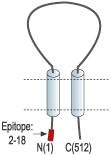Overview
- Peptide DLKESPSEGSLQPSSIQC, corresponding to amino acid residues 2-18 of human ASIC2a (Accession Q16515). Intracellular, N-terminus.

 Expression of ASIC2a in rat cerebellum and spinal cordImmunohistochemical staining of perfusion-fixed frozen rat brain and spinal cord sections using Anti-ASIC2a-ATTO Fluor-594 Antibody (#ASC-012-AR), (1:60). A. Staining in rat cerebellum sections reveals ASIC2a expression (red) in the molecular layer (MOL) of the cerebellar cortex. B. Staining in rat spinal cord sections shows labeling (red) of neuronal soma (horizontal arrow) in the ventral horn of the spinal cord. DAPI (blue) is used as counterstain in A and B.
Expression of ASIC2a in rat cerebellum and spinal cordImmunohistochemical staining of perfusion-fixed frozen rat brain and spinal cord sections using Anti-ASIC2a-ATTO Fluor-594 Antibody (#ASC-012-AR), (1:60). A. Staining in rat cerebellum sections reveals ASIC2a expression (red) in the molecular layer (MOL) of the cerebellar cortex. B. Staining in rat spinal cord sections shows labeling (red) of neuronal soma (horizontal arrow) in the ventral horn of the spinal cord. DAPI (blue) is used as counterstain in A and B.
- Kellenberger, S. et al. (2002) Physiol. Rev. 82, 735.
- Krishtal, O. et al. (2003) Trends Neurosci. 26, 477.
- Price, M.P. et al. (2000) Nature 407, 1007.
ASIC2a is a member of a family of Na+ channels that are activated by external protons. The family includes four additional members: ASIC1, ASIC3, ASIC4 and ASIC5. The ASICs are in fact part of a larger superfamily named degenerin/epithelial Na+ channels (DEG/ENaC) and share with it the same basic characteristics: two transmembrane spanning domains, a large extracellular domain and short intracellular N- and C-termini.
There are two recognized splice variants of the ASIC2 gene that differ on their N-termini, ASIC2a and ASIC2b that have different tissue distributions and functions. ASIC2a is highly expressed in the central nervous system (CNS) and is less expressed in the peripheral nervous system (PNS) while ASIC2b is prominently expressed in the latter.
The functional channel is composed of 4 subunits that can be assembled as homo- or heterotetramers with the other ASIC subunits. The ASIC2b splice variant does not appear to be functional when expressed alone but it can modify the properties of ASIC2a and ASIC3 when co-expressed.
The ASIC2 protein has been proposed to be involved in mechanosensation and sensory transduction.
Application key:
Species reactivity key:
Anti-ASIC2a Antibody (#ASC-012) is a highly specific antibody directed against an epitope of the human protein. The antibody can be used in western blot, immunoprecipitation, immunohistochemistry, and immunocytochemistry applications. It has been designed to recognize ASIC2a from human, rat, and mouse samples. The antibody is specific for ASIC2a and will not recognize the ASIC2b variant.
Anti-ASIC2a-ATTO Fluor-594 Antibody (#ASC-012-AR) is directly labeled with ATTO-594 fluorescent dye. ATTO dyes are characterized by strong absorption (high extinction coefficient), high fluorescence quantum yield, and high photo-stability. The ATTO-594 fluorescent label belongs to the class of Rhodamine dyes and can be used with fluorescent equipment typically optimized to detect Texas Red and Alexa-594. Anti-ASIC2a-ATTO Fluor-594 Antibody is specially suited to experiments requiring simultaneous labeling of different markers.
Applications
Citations
- Western blot analysis of human primary astrocyte lysate using #ASC-012. Tested in siRNA-treated cells.
Vila-Carriles, W.H. et al. (2007) J. Biol. Chem. 282, 34381.
